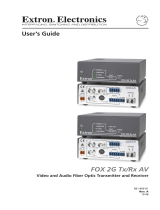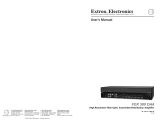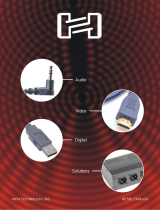Page is loading ...

1
Video/Audio
Transmission System
Series VA700
(formerly Series DVL4A)
November 2000

2
VIDEO/AUDIO
TRANSMISSION SYSTEM
INSTRUCTION MANUAL
SERIES VA700 & VA700M
General
The Series VA700 is a transmission system that converts video and audio
signals (RS170, NTSC, PAL, SECAM) to fiber at the transmitter inter-
face, and reconverts the signal to copper at the receiver.
Connections
Consult the diagrams for all pinouts.
Indicators - Receiver
The RED LED indicates that POWER is attached to the receiver and
that the internal fuses and voltage regulators are working.
The GREEN LED turns ON when sufficient optical power (light) is
received by the module from the fiber optic transmitter for the fiber optic
receiver to operate properly.
If the GREEN LED is OFF, check that (1) the fiber optic transmitter is
turned ON, and the fiber optic cable is plugged into the transmitter optical
connector; (2) the fiber optic cable is plugged into the receiver optical
connector; and (3) the RED LED is ON.

3
If the GREEN LED is still OFF, either (1) the fiber optic cable is broken,
(2) there is too much optical attenuation in the fiber optic cable, or (3)
either the transmitter or receiver fiber optic modules are defective. In
this case, please call Radiant Communications.
Indicators - Transmitter
The RED LED turns ON when power is applied to the transmitter. This
indicates that there is power supplied to the transmitter and that the
internal fuses and regulators are functioning properly.
Gain Control
Can boost or lower video signal on RX module.
Audio Connection
For balanced audio, ground wire must be connected to center of “Audio
In: and “Audio Out”. For single-ended (unbalanced) audio, connect Pin 1
to Pin 3 (ground - shield). Input/output audio at pin 2. For explanations on
AUDIO BALANCED and UNBALANCED see page 10.
Power Connection
Pin 1 +12V
Pin 2 GND
Pin 3 -12V
Problems
In case of problems, call Radiant Communications Technical Support toll-
free at 1-800-969-3427.

4
VA700-T
VA700-R
+12VDC
3
2
1
VIDEO OUT
CARRIER
POWER
RADIANT
COMMUNICATIONS
SERIES VA700-R
(800) 969-3427
- 12VDC
+12VDC
RADIANT
COMMUNICATIONS
SERIES VA700-T
(800) 969-3427
POWER
VIDEO IN
3
2
1
OPTICAL OUT
GROUND 3
AUDIO IN 2
AUDIO IN 1
- 12VDC
+12VDC
GROUND 3
AUDIO OUT 2
AUDIO OUT 1
3
2
1

5
System Specifications
POWER
Requirements ...................................................................... +/- 12VDC @500mA
Input/Output Level ........................................................................Video: 1V p-p
................................................................................ Audio: 0dBm (+10dBm max)
........................................................................ 600 ohm balanced or unbalanced
Input/Output Impedance ............................................................ Video: 75 ohms
................................................................................................ Audio: 10K ohms
Signal-to-Noise Ratio ...................... Video or Audio:>60dB @ 10dB attenuation
Audio Distortion.......................................................................................... <1%
System Bandwidth ..........................................................................Video: 8MHz
...........................................................................................Audio: 20Hzto 20kHz
Gain Control .......................................................... Fully automatic (AGC) based
................................................................................... on received optical power
OPTICAL
Optical Wavelength ................................................................... 1310nm/1550nm
Max. Attenuation ..................................................................................... 18dBm
CONNECTORS
Video ............................................................................................................BNC
Audio .................................................................................. 3-pin screw terminal
Optical ......................................................... AT&T type ST ceramic connectors
........................................................................ (other connector types optional)
ENVIRONMENTAL
Ambient Temperature Range .................................. 32
o
F to 120
o
F (0
o
C to +50
o
C)
Storage Temperature Range .............................. -40
o
F to +185
o
F (-40
o
C to +85
o
C)

6
+12 GRD -12
Power Plug
Fiber SC Connector
Fiber ST Connector
Audio Out
- + GND
Video Out
BNC
VA700-R
Rear Panel
+12 GRD -12
Power Plug
VA700-T
Rear Panel
Fiber ST Connector
Fiber SC Connector
Video In
BNC
Audio In
- + GND

7
IMPORTANT INFORMATION
The power supplies enclosed have been pre-wired due to the unconventional
colors of the transformer leads. For future reference, the leads and their corre-
sponding colors are listed in the table below. If there are any further questions
regarding the matter, please contact technical support at 1-800-969-3427.
+12V Pin 1
Ground Pin 2
-12V Pin 3

8
Audio Balanced & Unbalanced
Balanced vs. UnBalanced Audio Lines
Balanced lines use three wires with the outside wire being a shield around the
inside two. The inside two wires are thus shielded from external RF. The common
connectors for balanced audio is the XLR connector.
Unbalanced audio lines use just two wires, there is no shield. The signal passes
down the two wires unshielded from outside RF.
Home stereo connection cables are unbalanced line audio. The typical profes-
sional quality microphones use balanced line audio.
Balanced line connectors are XLR,
unbalanced line connectors are common to CamCorders and to stereo equipment
Unbalanced Audio
Most domestic audio equipment has unbalanced audio inputs and outputs. This
means that the audio output (left, right, or mono) appears on a single wire, and is
referenced to “0V” or “Ground”. Typical connectors used are RCA “phono”
connectors, DIN plugs/sockets, and 0.25" (6.3mm) or 3.5mm jack plugs/sockets.
Unbalanced audio is fine for the domestic environment, and for line-level signals
in a typical broadcast studio. Problems start to occur if the signals are being
carried over long distances, especially if the source and destination have
separate mains supplies.
Balanced lines
Balanced lines are different and a lot better. They use two signal conductors; one
carries the audio signal and the other carries an inverted copy of it. At the
receiving end, a special circuit takes the difference between the normal and
inverted signals. Any interference which gets into the cable is cancelled out
because it affects both signals equally.
Balanced cables have a screen too, but it plays no part in carrying the signal. If
the screen forms part of an earth loop, there will still be no interference.

9
What is an earth loop?
It is a loop of wire formed when you join two items of earthed equipment with
another earth wire. The classic example is when you connect the unbalanced
output of your amplifier (which is connected to earth via its mains lead) to the
unbalanced input of your mixer (which is also earthed via its mains lead) The
screen of the audio cable acts like another earth wire, joining the amplifier’s and
mixer’s earth points together.
The earth loop then goes; from your amplifier’s output, along the screen of the
audio cable, to the mixer input, via the innards of the mixer to the mixer’s mains
lead, down the mains lead to the wall socket, along the mains earth wire to the
socket where your amplifier is plugged, up the amplifier’s mains lead, via the
innards of the amplifier back to the amplifier output!
The huge loop of wire acts like an antenna picking up interference from mains
wiring. This causes large currents to flow in the loop. The current flowing in the
screen of your audio cable is picked up as an audio signal. It sounds like
BBBZZZZZZZZZZZ....
Connections ???
Balanced to Balanced
If you only ever connect balanced equipment to other balanced equipment, you
should never get any buzzes. You will only get audio noise when your units are
saturating or exceeding optical window budget.
Unbalanced to unbalanced
The most difficult is when both pieces of equipment are unbalanced. It is vital to
break the earth loop. Since you can’t break the screen of the audio cable, you
must ‘lift’ the ground of the TX and RX pin on VA700 set. If for instance you
use pin number 1 & 3 for your audio transmit and receive, connect pin 2 to
ground which is pin 3. You must do it on both units (Transmitter and Receiver).

10
If you get noise --check:
Broken leads are a very common cause of interference.
· Open XLR and jack plugs, and check that all wires are firmly connected
in place.
· Wiggle and stretch the cable while feeding a signal through it, to check
for breaks within the cable.
· Plug and unplug connectors several times to see if you have a dirty
contact (it’s a good idea to do this to every connector in your system
once a year)
· Check units for saturation
Make sure that you are not exceeding maximum optical dynamic range
for these units.
If this doesn’t produce an improvement, call RCC Tech Support 1-908-757-
7444 ...

11
Radiant Communications Corporation warrants that at the time of shipment the
products manufactured by Radiant Communications Corporation will be free from
defects in material and workmanship and will conform to the specifications
furnished by or approved by Radiant Communications Corporation.
Should any defects appear within one year from date of shipment, Radiant
Communications Corporation shall, at its sole discretion repair or replace the
defective material. Such material shall not be accepted for return or repair
without prior notification of Radiant Communications Corporation.
Return shipments to Radiant Communications Corporation shall be at the buyer’s
expense. Radiant Communications Corporation will return said equipment
prepaid via the best way.
The foregoing warranty is in lieu of and excludes any and all other expressed or
implied warranties of merchantability or fitness, or otherwise. Items manufac-
tured by any supplier other than Radiant Communications Corporation assumes
no responsibility for the performance or reliability of the product.
Radiant Communications Corporation will not be liable for any special or
consequential damages, or for loss, damages, or expense directly or indirectly
arising from the use of the products or any inability to use them either separately
or in combination with any other equipment or material or from any other cause.
This warranty does not extend to any product manufactured by Radiant Commu-
nications Corporation that has been subject to misuse, neglect, accident,
improper installation, act of God, or an violation of the instructions furnished by
Radiant Communications.
Warranty
/



